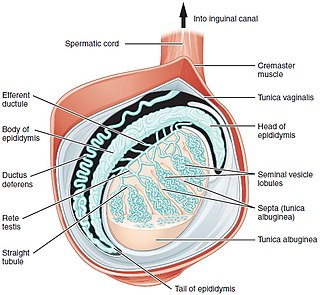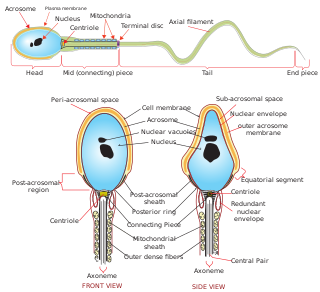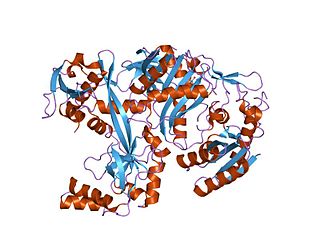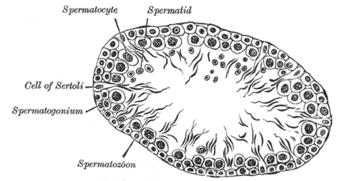
A testicle or testis is the male reproductive gland or gonad in all bilaterians, including humans. It is homologous to the female ovary. The functions of the testes are to produce both sperm and androgens, primarily testosterone. Testosterone release is controlled by the anterior pituitary luteinizing hormone, whereas sperm production is controlled both by the anterior pituitary follicle-stimulating hormone and gonadal testosterone.

Intracytoplasmic sperm injection is an in vitro fertilization (IVF) procedure in which a single sperm cell is injected directly into the cytoplasm of an egg. This technique is used in order to prepare the gametes for the obtention of embryos that may be transferred to a maternal uterus. With this method, the acrosome reaction is skipped.

A germ cell is any biological cell that gives rise to the gametes of an organism that reproduces sexually. In many animals, the germ cells originate in the primitive streak and migrate via the gut of an embryo to the developing gonads. There, they undergo meiosis, followed by cellular differentiation into mature gametes, either eggs or sperm. Unlike animals, plants do not have germ cells designated in early development. Instead, germ cells can arise from somatic cells in the adult, such as the floral meristem of flowering plants.

Spermatogenesis is the process by which haploid spermatozoa develop from germ cells in the seminiferous tubules of the testis. This process starts with the mitotic division of the stem cells located close to the basement membrane of the tubules. These cells are called spermatogonial stem cells. The mitotic division of these produces two types of cells. Type A cells replenish the stem cells, and type B cells differentiate into primary spermatocytes. The primary spermatocyte divides meiotically into two secondary spermatocytes; each secondary spermatocyte divides into two equal haploid spermatids by Meiosis II. The spermatids are transformed into spermatozoa (sperm) by the process of spermiogenesis. These develop into mature spermatozoa, also known as sperm cells. Thus, the primary spermatocyte gives rise to two cells, the secondary spermatocytes, and the two secondary spermatocytes by their subdivision produce four spermatozoa and four haploid cells.

The spermatid is the haploid male gametid that results from division of secondary spermatocytes. As a result of meiosis, each spermatid contains only half of the genetic material present in the original primary spermatocyte.

Spermatocytes are a type of male gametocyte in animals. They derive from immature germ cells called spermatogonia. They are found in the testis, in a structure known as the seminiferous tubules. There are two types of spermatocytes, primary and secondary spermatocytes. Primary and secondary spermatocytes are formed through the process of spermatocytogenesis.
Reproductive biology includes both sexual and asexual reproduction.

Sperm is the male reproductive cell, or gamete, in anisogamous forms of sexual reproduction. Animals produce motile sperm with a tail known as a flagellum, which are known as spermatozoa, while some red algae and fungi produce non-motile sperm cells, known as spermatia. Flowering plants contain non-motile sperm inside pollen, while some more basal plants like ferns and some gymnosperms have motile sperm.

The blood–testis barrier is a physical barrier between the blood vessels and the seminiferous tubules of the animal testes. The name "blood-testis barrier" is misleading in that it is not a blood-organ barrier in a strict sense, but is formed between Sertoli cells of the seminiferous tubule and as such isolates the further developed stages of germ cells from the blood. A more correct term is the "Sertoli cell barrier" (SCB).
The cells that give rise to the gametes are often set aside during embryonic cleavage. During development, these cells will differentiate into primordial germ cells, migrate to the location of the gonad, and form the germline of the animal.

Piwi genes were identified as regulatory proteins responsible for stem cell and germ cell differentiation. Piwi is an abbreviation of P-elementInduced WImpy testis in Drosophila. Piwi proteins are highly conserved RNA-binding proteins and are present in both plants and animals. Piwi proteins belong to the Argonaute/Piwi family and have been classified as nuclear proteins. Studies on Drosophila have also indicated that Piwi proteins have no slicer activity conferred by the presence of the Piwi domain. In addition, Piwi associates with heterochromatin protein 1, an epigenetic modifier, and piRNA-complementary sequences. These are indications of the role Piwi plays in epigenetic regulation. Piwi proteins are also thought to control the biogenesis of piRNA as many Piwi-like proteins contain slicer activity which would allow Piwi proteins to process precursor piRNA into mature piRNA.

Nuclear autoantigenic sperm protein is a protein that in humans is encoded by the NASP gene. Multiple isoforms are encoded by transcript variants of this gene.

Heat shock-related 70 kDa protein 2 is a protein that in humans is encoded by the HSPA2 gene.

5-azacytidine-induced protein 1 is a protein that in humans is encoded by the AZI1 gene.

NLRP14, short for NOD-like receptor family pyrin domain containing 14, is an intracellular protein of mammals associated with a role in spermatogenesis. It is also known as NALP14, NOD5, GC-LRR, Nalp-iota, PAN8, and CLR11.2, and is one of 14 pyrin domain containing members of the NOD-like receptor family of cytoplasmic receptors. NLRP14 is found exclusively in the testes where it is expressed within spermatogonia, spermatocytes and spermatids.

Tektin-1 is a protein that in humans is encoded by the TEKT1 gene.
A chromatoid body is a dense structure in the cytoplasm of male germ cells. It is composed mainly of RNAs and RNA-binding proteins and is thus a type of RNP granule. Chromatoid body-like granules first appear in spermatocytes and condense into a single granule in round spermatids. The structure disappears again when spermatids start to elongate. The chromatoid body is crucial for spermatogenesis but its exact role in the process is not known. Following significant strides in the understanding of small non-coding RNA mediated gene regulation and PIWI-interacting RNAs (piRNA) and their roles in germline development, the function of Chromatoid Bodies (CB) has been somewhat elucidated. However, due to similarities with RNP granules found in somatic cells – such as stress granules and processing bodies – chromatoid body is thought to be involved in post-transcriptional regulation of gene expression. Postmeiotic germ cell differentiation induces the accumulation of piRNAs and proteins of piRNA machinery along with several distinct RNA regulator proteins. Although evidence suggests CB involvement in mRNA regulation and small RNA mediated gene regulation, the mechanism of action remains obscure.

A spermatogonial stem cell (SSC), also known as a type A spermatogonium, is a spermatogonium that does not differentiate into a spermatocyte, a precursor of sperm cells. Instead, they continue dividing into other spermatogonia or remain dormant to maintain a reserve of spermatogonia. Type B spermatogonia, on the other hand, differentiate into spermatocytes, which in turn undergo meiosis to eventually form mature sperm cells.

Synspermiata is a clade of araneomorph spiders, comprising most of the former "haplogynes". They are united by having simpler genitalia than other araneomorph spiders, lacking a cribellum, and sharing an evolutionary history of synspermia – a particular way in which spermatozoa are grouped together when transferred to the female.















